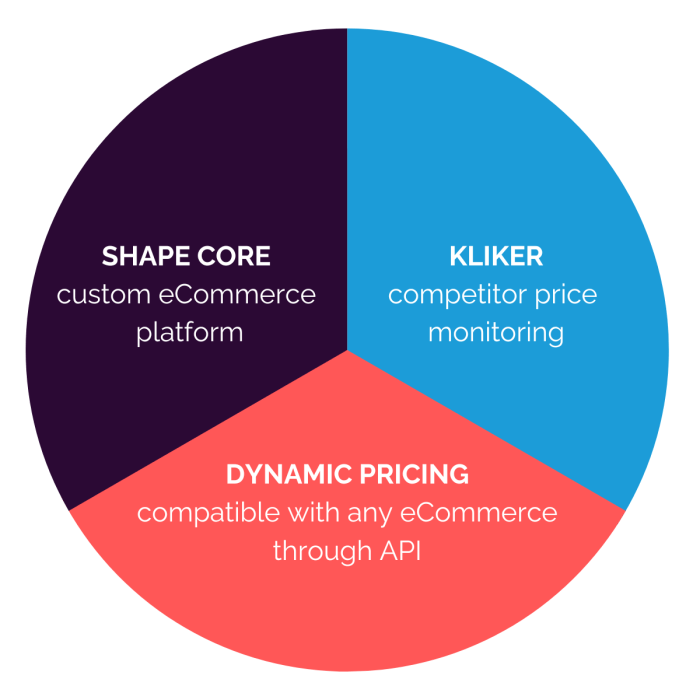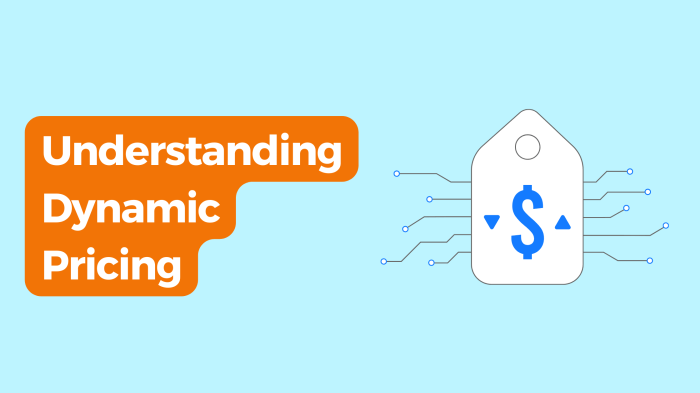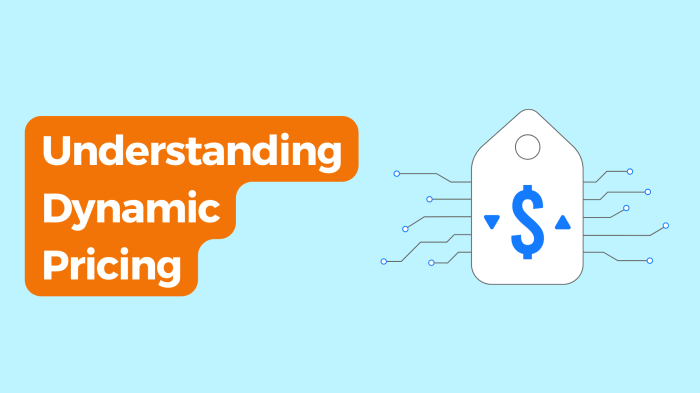How useful is dynamic media pricing? This exploration delves into the intricacies of adjusting media prices based on real-time market factors. From the ever-shifting tides of supply and demand to the impact of seasonality and competitor strategies, dynamic pricing offers a fascinating glimpse into the modern media landscape. Understanding its benefits and drawbacks is crucial for anyone involved in media sales or consumption.
The core principles behind dynamic media pricing revolve around optimizing revenue by responding to fluctuating market conditions. By analyzing variables like demand, inventory, and competitor pricing, businesses can fine-tune their strategies for maximum profitability. This dynamic approach contrasts sharply with traditional static pricing models, which often fail to capture the nuances of a rapidly changing market.
Defining Dynamic Media Pricing
Dynamic media pricing is a pricing strategy that adjusts the cost of media products or services in real-time based on factors like supply, demand, and market conditions. This approach, contrasted with static pricing, allows businesses to optimize revenue and better adapt to fluctuating market dynamics. It’s particularly relevant in sectors where demand is unpredictable or highly sensitive to external factors.Dynamic pricing strategies in the media landscape are rooted in the principle of maximizing revenue by matching prices to the value perceived by the consumer at any given moment.
This involves sophisticated algorithms and data analysis to understand and respond to changes in demand and market trends. The goal is to capture the highest possible price for a given product or service while still remaining competitive and attractive to potential customers.
Defining Dynamic Media Pricing
Dynamic media pricing, in essence, is a pricing model that adapts to real-time fluctuations in the market. Unlike static pricing, where prices remain constant, dynamic pricing is flexible and adjusts frequently in response to market conditions. The core difference lies in the continuous assessment of variables that impact the value proposition of the media offering.
Core Principles of Dynamic Pricing
Dynamic pricing strategies are built on the foundation of real-time data analysis. They leverage a variety of factors to determine the optimal price for a given media product or service. These factors often include supply and demand, competitor pricing, time of day, day of the week, seasonality, and even specific customer segments. The more data points available, the more refined the pricing strategy can become.
Dynamic media pricing can be incredibly useful for maximizing revenue, but understanding your target audience is key. Knowing how to reach professional services buyers, like those in the tech sector, for example, how to reach professional services buyers1 , is crucial to leverage these pricing strategies effectively. Ultimately, the success of dynamic pricing depends on a deep understanding of your customer base and their needs, leading to a better overall strategy.
Key Characteristics of Dynamic Pricing
Dynamic media pricing stands apart from traditional pricing models due to its responsiveness to the ever-changing marketplace. The key characteristics that distinguish dynamic pricing include:
- Real-time adjustments: Prices are not fixed but change frequently in response to shifts in market conditions.
- Data-driven decisions: Sophisticated algorithms and data analysis are essential to determine the optimal price at any given moment.
- Focus on value perception: The goal is to align prices with the perceived value of the media offering to the customer, maximizing revenue potential.
- Increased revenue potential: By responding to real-time market conditions, dynamic pricing can maximize revenue compared to static pricing.
Static vs. Dynamic Media Pricing
The following table highlights the key differences between static and dynamic media pricing models.
| Feature | Static Pricing | Dynamic Pricing |
|---|---|---|
| Price Adjustment | None | Frequent |
| Factors Influencing Price | None (or minimal) | Supply and demand, time of day, day of the week, seasonality, competitor pricing, and customer segments. |
| Customer Experience | Less personalized | More personalized (based on real-time data) |
Factors Influencing Dynamic Media Pricing
Dynamic media pricing, a strategy that adjusts prices based on real-time market conditions, is becoming increasingly prevalent. This adaptability allows businesses to optimize revenue and effectively manage resources. Understanding the forces behind these fluctuations is crucial for both media buyers and sellers. This in-depth look explores the critical factors that shape dynamic media prices, providing insight into the intricate dance of supply, demand, and market trends.Dynamic media pricing is driven by a complex interplay of factors, creating a constantly evolving landscape for buyers and sellers alike.
The core elements that influence price fluctuations include supply and demand, market trends, competitor strategies, seasonality, events, and inventory levels. These elements interact in intricate ways, often resulting in surprising price swings.
Supply and Demand
Understanding the fundamental economic principles of supply and demand is key to grasping dynamic media pricing. High demand for a specific media type, whether it’s a particular time slot on a popular television program or a specific in online advertising, typically leads to higher prices. Conversely, low demand results in lower prices. This dynamic is often influenced by current events, trending topics, or seasonal changes.
For example, during major sporting events, demand for advertising space surrounding those events skyrockets, driving up prices.
Market Trends and Competitor Pricing
Market trends play a significant role in influencing dynamic media pricing. Emerging trends and shifts in consumer preferences can cause a dramatic increase or decrease in demand for certain media formats. Furthermore, competitor pricing strategies often serve as benchmarks for media sellers. If competitors are offering similar media at lower prices, sellers may adjust their own pricing to remain competitive.
For instance, if a particular social media platform implements a new advertising feature that becomes exceptionally popular, other platforms might adjust their pricing for similar features to stay competitive.
Seasonality and Events
Seasonality significantly impacts media pricing. Demand for certain media often fluctuates throughout the year, based on seasonal trends. For instance, during the holiday season, advertising campaigns related to gift-giving increase, leading to higher prices for media placements during that period. Major events, like conferences or festivals, can also significantly impact pricing, as demand surges for media placements during these times.
The Super Bowl is a prime example, with extremely high demand and correspondingly high prices for advertisement slots.
Inventory Levels
Inventory levels, in the context of dynamic media pricing, refer to the availability of media slots, advertising spots, or similar assets. Limited inventory drives up prices. Conversely, ample inventory tends to reduce prices. A media company with a limited number of prime-time television spots available during a popular show will likely command a higher price for those spots than a company with a large inventory of such slots.
Table of Factors Impacting Dynamic Media Prices
| Factor | Description | Impact on Price |
|---|---|---|
| Demand | Number of customers seeking media | Increases price |
| Inventory | Amount of available media | Affects availability and price |
| Seasonality | Time of year | Influences demand and price |
| Market Trends | Overall market direction and consumer preferences | Impacts demand and, subsequently, price |
| Competitor Pricing | Pricing strategies of competitors | Serves as a benchmark for price adjustments |
Implementing Dynamic Media Pricing Strategies
Dynamic media pricing isn’t just about adjusting prices; it’s about creating a system that reacts to real-time market conditions. This responsiveness allows businesses to optimize revenue and stay ahead of the competition. A well-implemented dynamic pricing strategy leverages data and algorithms to make pricing decisions automatically, leading to more efficient and profitable operations.Successfully implementing a dynamic media pricing strategy requires a thorough understanding of the market, the target audience, and the available resources.
The goal is to create a system that is both responsive and predictable, maximizing revenue without alienating customers.
Process of Implementation, How useful is dynamic media pricing
Implementing a dynamic media pricing strategy involves several key steps. First, detailed market research is essential to identify factors affecting pricing. This includes competitor analysis, historical pricing trends, and seasonal patterns. Secondly, accurate data collection is vital to fuel the pricing algorithm. This could include real-time data on demand, inventory levels, competitor pricing, and economic indicators.
Finally, the implementation of the chosen pricing model and technology platform needs careful consideration and testing to ensure accuracy and efficiency.
Technologies and Software
Various technologies and software are used to facilitate dynamic media pricing. These tools automate the collection, analysis, and application of pricing data. Cloud-based platforms are common for their scalability and accessibility. Specialized dynamic pricing software often includes advanced analytics capabilities to help predict market trends and adjust prices accordingly. Dedicated e-commerce platforms, often used for digital goods and services, often incorporate dynamic pricing functionalities.
Dynamic media pricing, while seemingly straightforward, is becoming increasingly relevant. New research consulting buyer criteria and priorities are changing how companies approach these strategies, with a greater emphasis on customized solutions and measurable ROI. This shift means dynamic pricing needs to be more than just about adjusting rates; it must adapt to these evolving needs, becoming more sophisticated and data-driven to truly maximize its value.
Ultimately, dynamic media pricing’s effectiveness hinges on its ability to respond to the changing landscape.
Integration with CRM (Customer Relationship Management) systems allows for the collection of customer data for personalized pricing.
Methods for Setting and Adjusting Prices
Several methods can be used to set and adjust media prices dynamically. One popular approach is using a combination of market-based pricing and algorithmic adjustments. Market-based pricing considers competitor prices and perceived value to the consumer, while algorithms factor in historical data, demand forecasts, and inventory levels. Another approach uses a tiered pricing model, where different price points are applied based on various customer segments or product characteristics.
Price elasticity analysis helps determine how sensitive demand is to price changes, allowing for informed decisions. Furthermore, experiments on different price points can gather real-time data to refine pricing strategies and improve ROI.
Role of Algorithms
Algorithms play a crucial role in automating price adjustments within a dynamic media pricing strategy. They analyze various data points, such as demand, competitor pricing, and inventory levels, to determine optimal prices in real-time. These algorithms are designed to react to changes in the market and adjust prices accordingly. A key aspect of algorithms is their ability to learn from past data and refine their predictions over time.
A well-designed algorithm can automatically adjust prices to maximize revenue while maintaining profitability.
Step-by-Step Procedure for Developing a Dynamic Pricing Strategy
- Market Research and Analysis: Thoroughly research the market, including competitor pricing, historical trends, and seasonal patterns. Identify key factors influencing demand and supply.
- Data Collection and Integration: Establish a system for collecting relevant data, including demand patterns, inventory levels, competitor pricing, and economic indicators. Integrate these data sources into a central platform.
- Algorithm Development and Testing: Develop a pricing algorithm that considers the collected data. Rigorously test the algorithm to ensure accuracy and efficiency. Consider using machine learning techniques for more sophisticated predictions.
- Pricing Model Selection: Choose a pricing model that aligns with business objectives and target audience. Consider factors like price elasticity and competitor analysis. A tiered model, based on segments, could be an effective strategy.
- Implementation and Monitoring: Implement the chosen pricing strategy and continuously monitor its performance. Analyze sales data, adjust the algorithm as needed, and adapt to changing market conditions.
Benefits and Drawbacks of Dynamic Media Pricing
Dynamic media pricing, a strategy that adjusts prices based on real-time market conditions, offers a compelling approach to maximizing revenue. However, this flexibility comes with its own set of complexities and potential downsides. Understanding both the advantages and disadvantages is crucial for successful implementation and effective management of media pricing.
Advantages of Dynamic Media Pricing
Dynamic media pricing allows for a highly responsive approach to market fluctuations. By adjusting prices in real-time, businesses can capture the optimal value from their media inventory. This adaptability is particularly beneficial in dynamic markets, where demand and competitor pricing can change rapidly. This real-time adjustment can be seen as a key differentiator in competitive markets.
- Increased Revenue Potential: Dynamic pricing allows businesses to optimize prices based on current demand, maximizing the potential revenue from available media inventory. This can translate to significant revenue increases, particularly in high-demand periods or for limited-edition products.
- Optimized Pricing Strategies: Real-time data analysis allows for pricing strategies to adapt to changes in demand and competition, leading to optimal pricing at any given moment. This optimization can significantly improve revenue generation over time compared to static pricing models.
- Adaptability to Market Changes: Dynamic pricing allows businesses to respond quickly to market fluctuations, such as seasonal shifts, competitor actions, and economic changes. This responsiveness is vital in volatile markets where traditional pricing strategies might fall short.
- Improved Resource Allocation: By dynamically adjusting prices, businesses can better allocate their media inventory, ensuring that higher-demand assets are priced appropriately to maximize their value. This ensures efficient use of resources.
- Enhanced Customer Experience (Potentially): While not always the case, dynamic pricing can lead to enhanced customer experience if it’s implemented strategically. For example, providing exclusive discounts or promotions to early adopters can encourage faster sales.
Disadvantages of Dynamic Media Pricing
Implementing dynamic media pricing is not without its challenges. The complexity of the system and the need for constant monitoring can be significant drawbacks.
- Potential for Customer Dissatisfaction: Frequent price fluctuations can lead to customer dissatisfaction, especially if the price changes are perceived as unfair or unpredictable. This is especially true if the price changes are too frequent or large, leading to a negative impact on brand reputation.
- Complexity in Implementation: Dynamic pricing systems often require sophisticated software and data analysis capabilities, which can be complex and expensive to implement and maintain. The infrastructure requirements can be significant, particularly for large-scale operations.
- Need for Constant Monitoring: Dynamic pricing requires continuous monitoring of market conditions, competitor actions, and customer behavior. This ongoing monitoring can be demanding, requiring significant resources and attention.
- Potential for Pricing Manipulation: Dynamic pricing systems can be susceptible to manipulation by competitors. Competitors may attempt to exploit the system to their advantage, potentially impacting pricing stability.
- Data Dependency: Dynamic pricing relies heavily on accurate and real-time data. Inaccurate or incomplete data can lead to suboptimal pricing decisions, resulting in lost revenue opportunities.
Comparison with Static Media Pricing
Static media pricing involves setting prices once and maintaining them consistently. In contrast, dynamic pricing adjusts prices based on real-time factors. Static pricing is simpler to implement, but it lacks the responsiveness to market fluctuations that dynamic pricing offers. The choice between the two depends on the specific market conditions and the business’s goals.
Ethical Considerations
The ethical implications of dynamic media pricing deserve careful consideration. Exploiting customer segments based on their willingness to pay raises ethical concerns, especially if the price changes are perceived as unfair or discriminatory.
Dynamic media pricing can be incredibly useful for optimizing revenue, but understanding the intricacies of how it works is key. Thinking about whether SEO is something you can tackle yourself is crucial for effective online marketing strategies, and is SEO a DIY project ? Ultimately, dynamic pricing’s success depends on how well you manage it, aligning your pricing with market demand and competitor analysis.
A strong SEO foundation is vital for any business hoping to reach its target audience, and knowing whether it’s a DIY project will inform your strategy.
| Benefit | Drawback |
|---|---|
| Increased revenue | Potential for customer dissatisfaction |
| Optimized pricing | Complexity in implementation |
| Adaptability to market changes | Need for constant monitoring |
Case Studies of Dynamic Media Pricing: How Useful Is Dynamic Media Pricing

Dynamic media pricing isn’t just a theoretical concept; it’s a powerful tool used by businesses across various sectors to optimize revenue and adapt to market fluctuations. This section delves into real-world examples, showcasing how companies successfully implemented dynamic pricing strategies for various media types, and the results they achieved.Understanding the specifics of how different companies use dynamic pricing strategies and the results they achieved provides valuable insights into the potential benefits and challenges associated with this approach.
Airline Ticket Pricing
Airlines frequently utilize dynamic pricing for flights, adjusting ticket prices based on factors like demand, time of booking, and seat availability. This strategy allows airlines to maximize revenue by charging higher prices during peak travel seasons or for popular routes.
- Airlines often adjust prices based on competitor pricing, demand trends, and other factors. This can result in significant revenue increases compared to static pricing models.
- Dynamic pricing for flights helps airlines manage capacity and ensure sufficient revenue generation.
- Passengers may find that prices fluctuate considerably, making the best time to book a flight dependent on the specific travel dates and destinations.
Hotel Room Rates
Hotels employ dynamic pricing strategies to adjust room rates based on factors like seasonality, event calendars, and demand. By offering lower rates during off-peak periods, hotels can fill rooms and maximize revenue.
- Hotels often use algorithms to analyze data, including competitor pricing, demand trends, and historical booking patterns, to determine optimal pricing.
- Dynamic pricing helps hotels optimize room occupancy rates and generate higher revenue, especially during periods of low demand.
- Hotels often see a notable improvement in revenue by adapting their pricing strategies to the current market conditions and competitor pricing.
Streaming Content Subscription Pricing
Streaming platforms, like Netflix, sometimes use dynamic pricing strategies, but not always on a per-episode or per-movie basis. Instead, they often adjust pricing tiers based on subscription package features and competitor offerings. Changes in package structure and associated pricing can affect subscriber choices.
- Streaming services may introduce new tiers with varying price points to cater to different consumer segments and preferences.
- Pricing adjustments might occur due to changes in competitor pricing strategies or to align pricing with the value proposition of the service.
- The impact of dynamic pricing on streaming platforms can vary, influenced by consumer reactions to price changes and the overall market trends.
Advertising Space on Digital Platforms
Digital platforms, like Google and social media sites, employ dynamic pricing for advertising space. Factors such as the time of day, the target audience, and the popularity of the ad campaign can influence pricing.
- Advertisers can often bid on specific ad slots or target demographics through dynamic pricing systems.
- Digital platforms use sophisticated algorithms to determine the most profitable ad placements, optimizing revenue based on real-time market conditions.
- The use of dynamic pricing for advertising space can help platforms maximize revenue and provide advertisers with more targeted options.
Future Trends in Dynamic Media Pricing
Dynamic media pricing is rapidly evolving, driven by advancements in technology and data analysis. This evolution is poised to reshape how media is valued and consumed, offering both exciting opportunities and potential challenges for businesses and consumers alike. The future of dynamic media pricing will be characterized by increasingly sophisticated algorithms, personalized experiences, and a more integrated approach across various media platforms.
Emerging Trends and Technologies
Dynamic media pricing is no longer confined to simple supply and demand models. New technologies are pushing the boundaries of what’s possible. This includes real-time bidding systems that adjust prices based on instantaneous market conditions, predictive modeling that forecasts demand fluctuations, and AI-powered personalization that tailors prices to individual viewer preferences.
Impact of Artificial Intelligence and Machine Learning
AI and machine learning are revolutionizing dynamic media pricing. Sophisticated algorithms can analyze vast amounts of data, including viewer behavior, content consumption patterns, and even contextual factors like time of day and location. This allows for more precise and personalized pricing strategies. For instance, a streaming service could offer premium content at a lower price to viewers who consistently watch it during off-peak hours, while simultaneously increasing prices during peak times.
Role of Data Analytics in Future Strategies
Data analytics will be crucial for future dynamic media pricing strategies. By analyzing user data and market trends, companies can gain insights into viewer preferences, content consumption patterns, and price sensitivity. This information allows for the development of more accurate pricing models that optimize revenue and enhance user experience.
Innovative Applications of Dynamic Pricing in Media
Dynamic pricing in media is finding innovative applications across various platforms. For example, news organizations could adjust article pricing based on the urgency and importance of the news, or social media platforms could vary ad rates based on the audience’s engagement with specific content. Personalized subscription packages tailored to individual viewer preferences are also becoming increasingly common. For instance, a streaming service could offer different tiers of content access, each with varying prices and features, based on user demographics and viewing habits.
Future Challenges and Opportunities
The future of dynamic media pricing presents both challenges and opportunities. Ensuring fairness and transparency in pricing algorithms is crucial to avoid consumer backlash. Ethical considerations regarding data privacy and algorithmic bias also need careful attention. However, the potential for personalized experiences and optimized revenue generation remains significant. Furthermore, the convergence of different media platforms will create new opportunities for integrated dynamic pricing models, allowing for a more seamless and customized user experience across various channels.
Conclusive Thoughts

In conclusion, dynamic media pricing presents a compelling blend of potential rewards and significant challenges. While the ability to adapt to market fluctuations and potentially boost revenue is undeniable, careful consideration of customer experience, ethical implications, and implementation complexities is paramount. The future of dynamic pricing in media will undoubtedly be shaped by emerging technologies and data analytics, promising both exciting opportunities and unforeseen obstacles.
Ultimately, understanding how useful dynamic media pricing is hinges on a comprehensive assessment of its strengths, weaknesses, and potential impact on various stakeholders.





